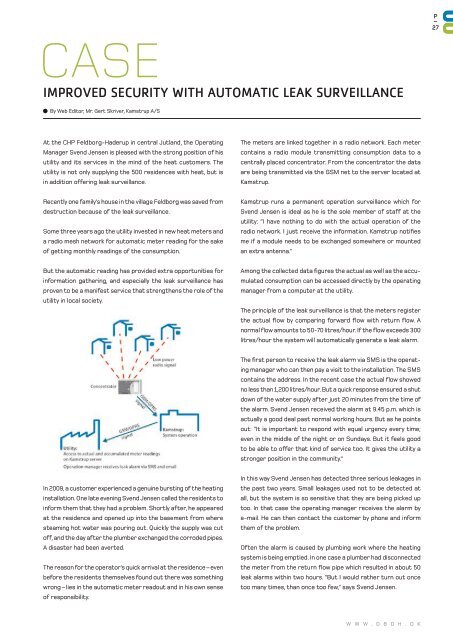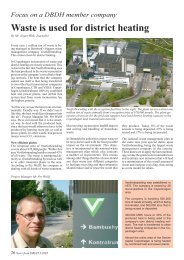Download - DBDH
Download - DBDH
Download - DBDH
Create successful ePaper yourself
Turn your PDF publications into a flip-book with our unique Google optimized e-Paper software.
imPRovEd sECuRity with AutomAtiC lEAk suRvEillAnCE<br />
By web editor, Mr. gert skriver, Kamstrup A/s<br />
At the cHp Feldborg-Haderup in central Jutland, the operating<br />
Manager svend Jensen is pleased with the strong position of his<br />
utility and its services in the mind of the heat customers. the<br />
utility is not only supplying the 500 residences with heat, but is<br />
in addition offering leak surveillance.<br />
recently one family’s house in the village Feldborg was saved from<br />
destruction because of the leak surveillance.<br />
some three years ago the utility invested in new heat meters and<br />
a radio mesh network for automatic meter reading for the sake<br />
of getting monthly readings of the consumption.<br />
But the automatic reading has provided extra opportunities for<br />
information gathering, and especially the leak surveillance has<br />
proven to be a manifest service that strengthens the role of the<br />
utility in local society.<br />
in 2009, a customer experienced a genuine bursting of the heating<br />
installation. one late evening svend Jensen called the residents to<br />
inform them that they had a problem. shortly after, he appeared<br />
at the residence and opened up into the basement from where<br />
steaming hot water was pouring out. Quickly the supply was cut<br />
off, and the day after the plumber exchanged the corroded pipes.<br />
A disaster had been averted.<br />
the reason for the operator’s quick arrival at the residence – even<br />
before the residents themselves found out there was something<br />
wrong – lies in the automatic meter readout and in his own sense<br />
of responsibility.<br />
the meters are linked together in a radio network. each meter<br />
contains a radio module transmitting consumption data to a<br />
centrally placed concentrator. From the concentrator the data<br />
are being transmitted via the gsM net to the server located at<br />
Kamstrup.<br />
Kamstrup runs a permanent operation surveillance which for<br />
svend Jensen is ideal as he is the sole member of staff at the<br />
utility: “i have nothing to do with the actual operation of the<br />
radio network. i just receive the information. Kamstrup notifies<br />
me if a module needs to be exchanged somewhere or mounted<br />
an extra antenna.”<br />
Among the collected data figures the actual as well as the accumulated<br />
consumption can be accessed directly by the operating<br />
manager from a computer at the utility.<br />
the principle of the leak surveillance is that the meters register<br />
the actual flow by comparing forward flow with return flow. A<br />
normal flow amounts to 50-70 litres/hour. if the flow exceeds 300<br />
litres/hour the system will automatically generate a leak alarm.<br />
the first person to receive the leak alarm via sMs is the operat-<br />
ing manager who can then pay a visit to the installation. the sMs<br />
contains the address. in the recent case the actual flow showed<br />
no less than 1,200 litres/hour. But a quick response ensured a shut<br />
down of the water supply after just 20 minutes from the time of<br />
the alarm. svend Jensen received the alarm at 9.45 p.m. which is<br />
actually a good deal past normal working hours. But as he points<br />
out: “it is important to respond with equal urgency every time;<br />
even in the middle of the night or on sundays. But it feels good<br />
to be able to offer that kind of service too. it gives the utility a<br />
stronger position in the community.”<br />
in this way svend Jensen has detected three serious leakages in<br />
the past two years. small leakages used not to be detected at<br />
all, but the system is so sensitive that they are being picked up<br />
too. in that case the operating manager receives the alarm by<br />
e-mail. He can then contact the customer by phone and inform<br />
them of the problem.<br />
often the alarm is caused by plumbing work where the heating<br />
system is being emptied. in one case a plumber had disconnected<br />
the meter from the return flow pipe which resulted in about 50<br />
leak alarms within two hours. “But i would rather turn out once<br />
too many times, than once too few,” says svend Jensen.<br />
w w w . D B D H . D k<br />
p _<br />
27
















